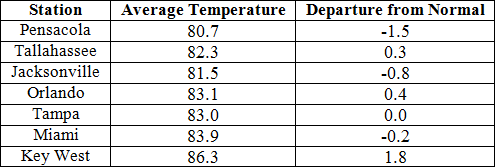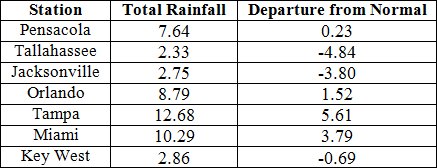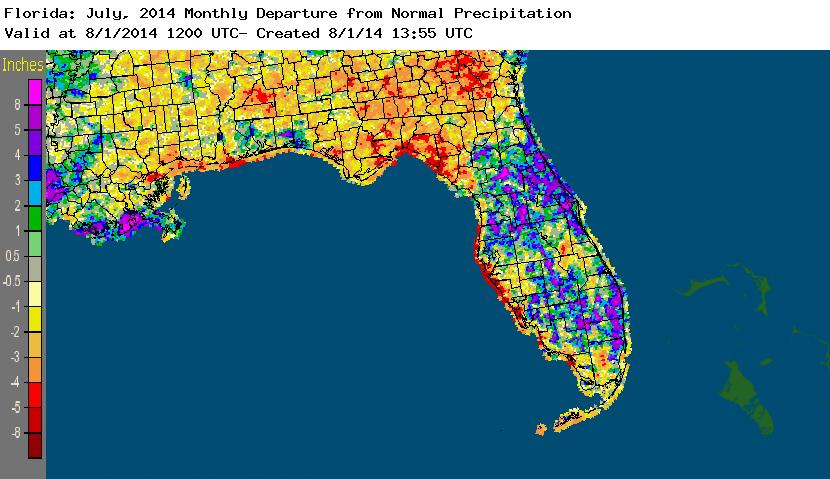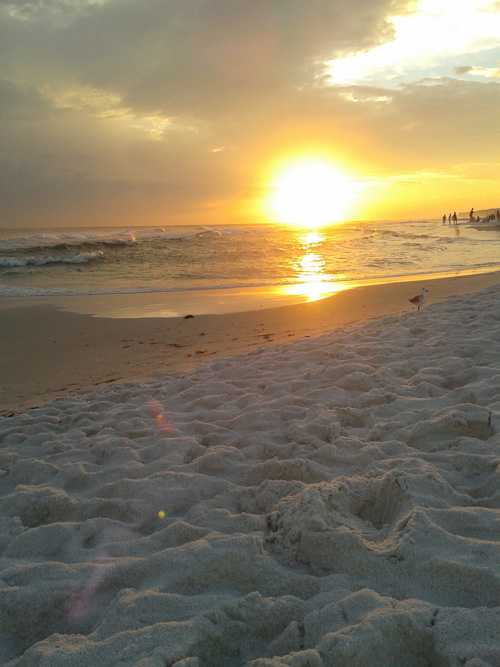Dear Florida Climate Center Friends,
We'd like to present you with the August 2014 edition of our newsletter. In this newsletter, you'll find our monthly climate summary, a list of special events that our staff attended, some pictures, and more. If you have any questions, please email us at climate@coaps.fsu.edu.
Thanks,
The Staff of the Florida Climate Center
 |  |  | David Zierden
State Climatologist | James O'Brien
Professor Emeritus | Melissa Griffin
Asst. State Climatologist |
|
July Climate Summary for Florida
The Florida Climate Center's July 2014 Florida Climate Summary is now available. The summary provides an analysis of temperature and precipitation trends across the state, along with data on hazardous weather, drought, the impacts of the weather and any records tied or broken for the month. During July, average temperatures and rainfall totals varied across Florida. ENSO-neutral conditions are continuing in the equatorial Pacific. The Climate Prediction Center (CPC) predicts above normal temperatures and normal precipitation for the state through October. Past summaries are archived here.
| July average temperatures and departures from normal (°F) for select cities. |  |
| July precipitation totals and departures from normal (°F) for select cities. |  |
| A graphical depiction of the monthly rainfall departure from normal (inches) for July (courtesy of NOAA, NWS). |  |
|
|
Update on the Current Situation of El Niņo
With the Climate Prediction Center's El Niņo Watch still in place, conditions in the equatorial Pacific show that the sea surface temperatures have cooled and an El Niņo could be a 'no-show'.
State Climatologist David Zierden has a special report on the current state of the potential El Niņo:
http://climatecenter.fsu.edu/el-nino-or-el-no-show
|
|
AASC Holds 39th Annual Meeting
The American Association of State Climatologists (AASC) held their 39th annual meeting at the Skamania Lodge in the scenic Columbia River Gorge on July 9th through 12th this year. The AASC is a professional organization that was formed in 1976 following the elimination of the State Climatology program from NOAA. The 2014 meeting was co-hosted by the Washington and Oregon State Climate Offices and they dialed up beautiful weather and surroundings for the meeting. Here is a spectacular view of the Gorge from Crown Point.

Some interesting climate facts about the Columbia River Gorge... it was formed at the end of the last ice age as great floods rushed through the valley in a series of catastrophic events. The floods were a result of glacial melt-water released as ice-dams broken, freeing tremendous amounts of water from the Missoula Lakes. Another climate fact, the geography and shape of the Gorge and prevailing wind patterns funnel the wind over the wide Columbia River, making it one of the best spots in the world for sailboarding and kite surfing!
In the meeting, the membership heard the latest strategies for climate services from our federal partners and about projects and science from the Regional Climate Centers and various State Climate Offices. In the business meeting, the plan of hiring and executive director was discussed further and Florida State Climatologist David Zierden was elected AASC Treasurer.
|
|
Community Outreach
Assistant State Climatologist Melissa Griffin took part in two outreach presentations last month during the Taylor County's 4-H Weather and Ocean Summer Camp. Ms. Griffin gave a presentation to students on the basics of weather before the students took part in a variety activities that ranged from a rain gauge relay race, exploring the journey of a water molecule, and learning about the impacts of storm surge on coastal communities.
Later that week, the same group of students came to FSU's Center for Ocean-Atmospheric Prediction Studies (COAPS) to learn more about the marine sciences. Alongside Ms. Hannah Hiester and Ms. Brittany Pace, representatives from the students moved through 3 different stations where they learned about density and gravity currents, sea breezes and saltwater intrusion, and view various marine specimens pulled from the Gulf of Mexico.

|
|
Upcoming Events
August 12, 2014:
Advanced Farming Technologies for Reducing Climate Risks in Blackville, SC
September 3-5, 2014:
Southern Region Extension Climate Academy in Athens, GA
November 19-21, 2014:
Fall Review of the Southeast Climate Consortium in Auburn, AL
|
|
Special Report: UV Exposure
While there are a variety of weather hazards, such as rip currents, lightning, and heat, that tourists (and even locals) need to become aware of during their time spent outdoors. However, there is one hazard that can escapes notice until the damage has already been done: UV exposure. Most summertime activities have people out and about, be it at the pool, amusement park, or along the beach and more often than not, they forget to protect themselves against the sun's UV rays. Even in the winter, people are still exposed to higher amounts of UV rays in Florida than other places in the U.S.
Dr. Ed Brotak, a meteorologist and writer, recently contacted the Florida Climate Center to get some additional information and perspective about the dangers of too much sun exposure. You can read the article, along with advice to limit your exposure, in the July/August edition of Times of the Islands magazine.
http://timesoftheislands.com/dm/2014/jul-aug#page/62

|
|
About Us
The Florida Climate Center is part of a three-tiered system of national, regional, and state climate offices, including NOAA's National Climatic Data Center and the Southeast Regional Climate Center. The Florida State Climatologist and other staff at the Florida Climate Center provide the following information and services to the people of Florida:
· Climate Data:
Historical weather observations for weather stations throughout the state of Florida. We are able to provide data for most stations from 1948-present.
· Climate Information:
Long-term historical averages for various stations, climate divisions, and the entire state.
· Extreme Event Records:
Information and analyses on extreme events such as freezes, droughts, floods and hurricanes.
· Special Analysis:
With their vast knowledge of El Niņo, La Niņa and climate variability, the State Climatologist and staff can offer expert insight into Florida's climate trends.
· Outreach:
Activities, presentations, and workshops that inform and educate the people of Florida about current and emerging climate issues. We also coordinate volunteers for the Community Collaborative Rain, Hail & Snow Network (CoCoRaHS).
More About Us
|
|